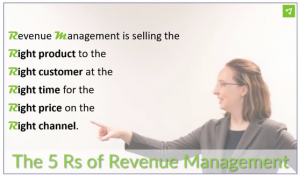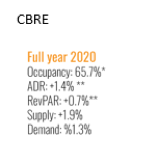4 Tips for generating creative, targeted strategies for 2020
The 5 Rs of Revenue Management
Most hotels are seasonal, but each market has very different needs in each quarter. For example, Minneapolis is not busy in Q1, while Phoenix is in high season. However, it is crucial for Revenue Managers to look at the 5 Rs of Revenue Management regardless of the season.
When was the last time you as a Revenue Manager looked at these components for your hotel? How often are you looking at these components? Ideally, this information should be analyzed at least semi-annually – _even better, quarterly.
With asset managers and management companies focused on profits, this might be the best time to take a look and make sure your strategy is attracting the RIGHT guest.
RevPAR projections for 2020
- Asian Hospitality predicts that RevPAR will remain flat.
- Hotel News Now reports that both STR and CBRE show occupancy falling slightly and ADR showing a slight increase.
4 Expert Tips for profitable gains in 2020
- Evaluate your Channel management/distribution
With so many ways for a customer to book your hotel, it is important to understand the cost of each distribution channel. Not all guests book the same way, and the cost of each channel can vary.
Most popular channels
- Hotel Direct
- GDS (Global Distribution Solutions)
- OTAs (Online Travel Agencies such as Expedia and Booking.com)
If most of your business comes from the OTA channel, but has a cost of 20% associated with it, it might be beneficial to try gaining more direct bookings with lower cost acquisition.
A Profit Launch Assessment can evaluate how your business is booking and the cost associated with this business. This helps you determine your most profitable channels.
- Target the right audience
Determine who the ideal customer is for your hotel. This will help direct your marketing funds and price your hotel accordingly.
What types of customers stay at your hotel? What demographics define the types of customers you attract? Families? Couples? Multi-generational guests?
This is important because if, for example, your hotel is not popular with the more mature clientele, it might not make a difference that your AARP discount is 5% or 25%. Having this information available will help you accurately define your target market.
Where do your customers come from? Review your feeder cities to determine where you should be marketing. If most of your travelers are within a 5-hour driving radius of your hotel, it would be wise to target guests in that area. Perhaps offering a special rate for guests in the tri-state area or a specific zip code would be effective. If your hotel attracts guests from certain countries, you could have a few amenities that they would find beneficial.
Booking windows also vary based on clientele and feeder cities. Knowing when each type of business books can help determine the most profitable business to attract and the best time to promote different types of business.
On your website, increase conversion by highlighting the attributes of your hotel that will appeal to your ideal customer. If your hotel attracts families that are in the drive-in market, you could promote parking, family activities in the area, breakfast or other options that would appeal to families when they stay with you.
- Create an unconstrained demand forecast
Unconstrained Demand forecast looks at how many rooms you could sell if you had unlimited inventory. This is different from a monthly operational forecast.
To create an unconstrained demand forecast, consider how many rooms you have sold on a specific date, and how many rooms you could sell for that date. Creating a demand forecast for the year will help determine a marketing calendar to maximize the return on marketing dollars spent. This also helps synergize revenue management and marketing so they are working together to create a unified plan.
How to use the information in your unconstrained demand forecast
- Determine when you have opportunity to increase rate or eliminate discounts.
- Find dates that may need more assistance and possibly target specials to help increase demand.
- Shop your competition
When was the last time you shopped your competition? If you haven’t evaluated this in the past 6 months, you might be losing out on revenue opportunities. Looking at each of your competitors on their brand sites, the OTA sites and Trip Advisor will help you understand what they are doing, and how guests are reacting to them.
Each hotel should have a list of the following regarding their competitors:
- what amenities they have at the hotel
- what specials they have in place each day
- who their top accounts are
This should be updated regularly, at least twice a year or as you notice a shift in your business.
Reading your competitors’ guest reviews will help you determine how to sell against them as well as provide insight to what is happening at that particular hotel. what is happening at that particular hotel.
Who, How, Where, When & Why of 2020
Whether 2020 proves to be a challenging year or smooth sailing, properties need to utilize every tool available. If used properly and frequently, your hotel will stand above the rest. Narrowing down who your customer is, how they are booking at your hotel, where are they coming from, when are they coming and why they should choose your hotel are great steps in helping your hotel gain share over the competitors.
By Jennifer Koll
Brand Systems Manager, Total Customized Revenue Management, LLC.








